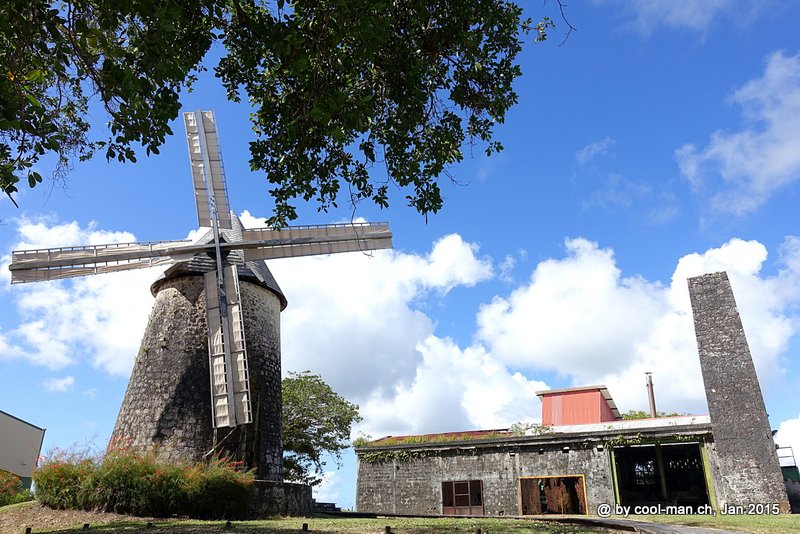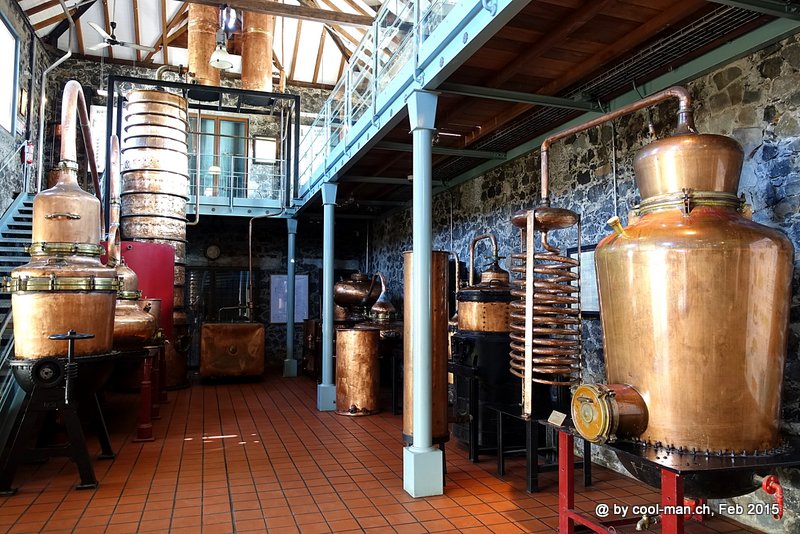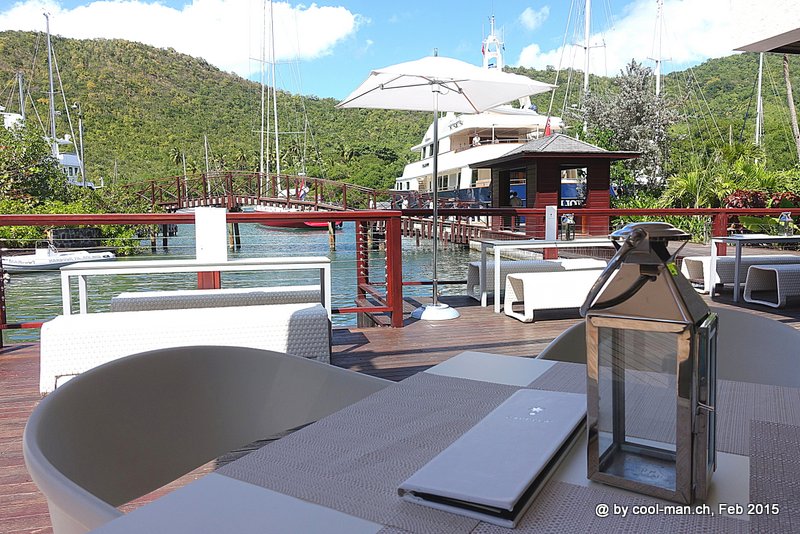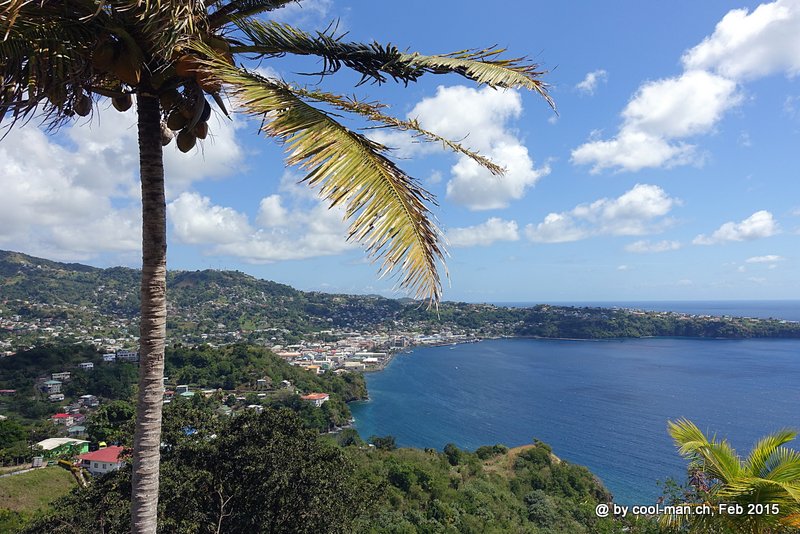January to March 2015
Coming from Panama, I decided to do island hopping in the Lesser Antilles. My journey led me from Guadeloupe to Grenada. Since the area is known for its rum production, I wanted to visit as many distilleries as possible and taste their rum.
Guadeloupe
Guadeloupe is part of France, so I could only show my Swiss identity card when entering the island. Since public transport hardly exists and taxis were very expensive, I rented a car to explore the island. I lived in a great resort right at the beach Grande Anse, probably the best and not overcrowded beach in Guadeloupe. It is a great feeling to swim a few rounds in the crystal clear sea before breakfast. Guadeloupe consists of the two main islands Grande Terre and Basse Terre, which are separated by a narrow channel. Grande Terre is flat and has the most touristic beach at the village Saint Anne. Basse Terre is less touristy and very hilly. The volcano Soufriere dominates the southern part of this island. The area around the volcano is a national park and offers hiking possibilities.
Deshaies Botanical Garden
Deshaies Botanical Garden on Basse-Terre Island


Island Marie-Galante
Next I visited the small island Marie-Galante, which belongs to Guadeloupe and has three distilleries. I visited the distilleries by bike. The distilleries didn’t inspire me, neither did those on the main island Guadeloupe. Apart from one, they have very old facilities. Under these conditions it is difficult to keep the exact temperature constant when distilling, which was noticeable when tasting. Nevertheless, it was interesting to visit these historical facilities.
Another perfect beach

Distillery Bellevue


Dominica
The next island on my trip was Dominica. Although the island is only 30 km away from Guadeloupe, the two islands are very different. On the former British crown colony Dominica English is spoken and there is left-hand traffic. The currency is here like on most islands of the Lesser Antilles the East Caribbean Dollar, which is fixed to the US Dollar. Dominica became an independent country in 1978, which, with around 72,000 inhabitants, is one of the smallest countries in the world. With 16,000 inhabitants, the capital Roseau is more of a village than a capital. On the ferry from Martinique to Dominica I met two Swiss men with whom I rented a car. I was very happy about my two travel colleagues, because as a precautionary measure I would not have gone hiking alone and could probably only have gone on an organized tour. Since Dominica rises very steeply, it rains every day briefly and violently. The climate is warm and very humid, so that extremely dense forests with an unbelievable variety of plants could develop, as I have not found them anywhere before. Dominica markets itself as a nature destination and accordingly the hikes are the main attractions. On the ship I met a German couple who wanted to hike the so-called Waitukubuli National Trail in 14 days. This hiking trail leads over 184 km through the whole island and covers all highlights of Dominica. With the two Swiss I made several hikes to impressive waterfalls. Because of the high humidity the paths were very slippery.
Boiling Lake
The highlight was the 3-hour hike to Boiling Lake (and back again 3 hours). This lake is located in a crater, from which hot fumes constantly escape and bring the lake to boiling point. Further down, the outflow from Boiling Lake flows into natural pools where we could bathe in warm, mineral-rich water.
On the way to “Boiling Lake”


The Boiling Lake

The warm outflow from Boiling Lake is rich in minerals.

Champagne Pool
On a beach hot gases rose out of the sand, which warmed the water and rose to the surface like champagne bubbles through the water. The place is aptly called “Champagne Pool”.
Like all Caribbean states, also Dominica is called by cruise ships.

Martinique
Martinique is another French island. It is the only one to have been awarded an Appellation d’Origine Contrôlée (AOC) for its rum. Here the distilleries invested in their production facilities. They are therefore technically at a much higher level than in Guadeloupe. With the rental car I visited all seven distilleries.
Distillery Clement
The “Single Cask Très Vieux Rhum Agricole” from 2003 from the Distillery Clement was my favorite. As the name “Single Cask” says, this rum comes from a single, particularly highly refined barrel. Rum is usually mixed together from different barrels before bottling.
The plantation house


These rollers were used to press out the sugar cane plants.

A resort owner on Saint Vincent, who knows most of the rums from the Caribbean region, was just as enthusiastic about the Clement Rum, which was noticeable in the fill level of the bottle. I lived in the south of the island near Saint Luce. A few minutes walk from my resort there was a perfect beach that stretched for four kilometers to the village of Saint Luce. A wonderful walk. Not far away from Saint Luce there is another very nice beach, Grande Anse des Salines. Unfortunately, there are no deserted beaches in Martinique, especially not during the French holidays.
Distillery St. James
A museum with old distilling equipment on the distillery St. James

Sugar cane: Wars were waged over this plant

Saint Lucia
The history of the next island Saint Lucia is like that of Dominica influenced by England. In the capital Castries a few cruise ships moor every day. North of Castries is the Rodney Bay, where there are shopping centers, shops of international brands, chic restaurants and a marina. Here I met a German woman again, with whom I was on a sailing trip to Boracay a few years ago. Coincidences …
Soufrière
The small village Soufrière lies picturesquely in a bay

A petrol station in Soufrière

I stayed in Soufrière in the south of the island. This is the much more beautiful and quiet part. Two remaining fossilized lava chimneys rise as several hundred meters high rocks. The two mountain peaks are called Piton and are the landmark of Saint Lucia.
One of the two Piton’s, the landmarks of Saint Lucia

In the surroundings there are hot sulphur springs in whose water you can swim. On a few hiking trails you can enjoy fantastic views of the Piton’s, the palm forests and the endless blue sea.
Marigot Bay
Marigot Bay is a picturesque bay with a few great resorts visited by yachts.
The chic Marigot Bay

Saint Lucia Distellery
The only distillery on the island is located between Soufrière and Castries. Since sugar cane cultivation on the island was abandoned in favor of bananas, rum is produced here on the basis of imported molasses, a waste product from sugar production. This is why the taste of the rum differs from that of Martinique, where the freshly harvested sugar cane is processed directly on the distillery.
At the Saint Lucia Distellery
Saint Vincent and the Grenadines
Next on my route to Grenada I visited the country “Saint Vincent and the Grenadines”. It consists of the main island Saint Vincent and a number of smaller islands that are spread over 60 km in the direction of Grenada.
Kingstown
The capital of Saint Vincent, Kingstown, is located directly at the sea.
The capital Kingstown seen from the fort

The Kingstown Fish Market

Nevertheless, there is not a single restaurant or bar with a sea view. Tourism is concentrated on a few resorts only a few kilometres away from Kingstown.
Saint Vincent Distillers
The only distillery on the island produces rum from molasse. Nevertheless, the rum named after Captain Bligh (the captain of the mutinied ship “Bounty”) was surprisingly good and also won some prizes.
Saint Vincent Distillers

On my way to Grenada I traveled on to the Grenadine Islands.
Bequia Island
The first island was Bequia, whose capital Port Elizabeth lies idyllically in a bay. The many restaurants and cafes are mainly visited by the people on the yachts. A great beach is only a few minutes walk from the village. Sometimes in the evening a band played Caribbean melodies on their barrels and the guests danced into the night.
Union Island
The Union Island with the capital Clifton was my next destination. Some resorts and restaurants are located directly at the crystal clear, light blue sea. A historic fort is strategically located with a fantastic view over the nearby islands of Palm Island and Mayreau and their coral reefs.
View from Fort on Union Island

Tobago Cays
Also the islands of the protected area of the Tobago Cays could be seen. A visit to the Tobago Cays is a must on any itinerary. The five small islands are uninhabited, so that the few visitors who mainly come with their own yacht have the beautiful beaches and reefs for themselves. As the pictures show, it is an extremely worth seeing place.
National Park of the Tobago Cays: The most beautiful place on my trip in the Caribbean


I also met this lizard in the Tobago Cays National Park.

Grenada
Carriacou Island
My next destination, the island of Carriacou, was already part of the next country Grenada. Since there is no passport control at the small port of my starting point on Union Island, I had to get the exit stamp at the airport the day before. Then I went early in the morning with an old barge, whose sails supported the ship’s engine, on the crossing. The main town of Carriacou is a sleepy little town. I had just arrived and saw a western woman walking by who looked as if she had been living on the island for some time. I approached her so that I could perhaps get some information about the island. The woman turned out to be Hilde, a Swiss organic farmer. She just met her colleague Astrid, another Swiss woman and Zumba instructor. I moved to her resort at the most beautiful beach of the island with the fitting name “Paradise Beach”, where I met the Canadian Sylvia who escaped the winter for a few months. The three women mothered me like a returned son.
The Paradise Beach: From the resort it is only a few steps to the beach.

View from a hike on the island of Carriacou

Grenada
The last stop of my Caribbean trip was the island Grenada with the capital St. George, which lies picturesquely in a bay.

The island is also called Spice Island, because here innumerable spices grow. The island is one of the largest exporters of nutmeg.

Nutmegs are dried

… and then filled into bags for transport.

On Grenada there are three distilleries, two chocolate factories, a micro-brewery and a traditional brewery.
The distilleries are geared to demand, which means that they produce a high percentage of alcohol (69% alcohol upwards). Customers are primarily interested in getting drunk as quickly as possible. The taste of rum is secondary.
Antoine Rum Distillery
Antoine Rum Distillery: The only distillery in the Caribbean region that still presses the juice out of the sugar cane with the help of a water wheel. A wonderful historical installation!


Grenada Chocolate Factory
Grenada has been producing cocoa for centuries. In 1999, an American do-gooder founded the Grenada Chocolate Factory and was able to keep the entire value chain from bean to chocolate in the country. It was the only chocolate factory in a cocoa-producing country. Different varieties with up to 100% cocoa are offered. What an intense taste! Even in the luxury department store Harrods in London the chocolate is in the assortment. About a year ago, a second chocolate factory opened its doors.
From the cocoa bean to the chocolate bar, all production steps are carried out by the company itself.
The cocoa beans

… drying

… and blanching

The micro-brewery was probably more a beer idea of a few Englishmen, because it is not run professionally.
“Le phare bleu” at the Calvigny Bay
I also visited the resort opened by the Swiss ex-TV-woman Jana Caniga and her husband with the associated marina. Although her husband is a rich industrial heir, they have far too much to do with the resort and, more recently, with the management of the Swiss consulate, so there is hardly any free time left. It is incomprehensible to me why these people put themselves under pressure even though they could enjoy life.
Calvigny Bay: A former Swedish lighthouse ship is the landmark of the resort “Le phare bleu” of ex-TV-woman Jana Caniga and her husband.

Grand Etang
On the last day I made a hike from Grand Etang to the second highest peak of the island, Mount Qua Qua. Grand Etang is a lake in a huge crater of an extinct volcano.
Grand Etang: A lake in a huge extinct volcano (the mountains at the back form the crater rim).

The history of the Lesser Antilles is interesting. All the islands were conquered more than a dozen times alternately by France and England in the 17th and 18th century, as the islands made high profits with their sugar cane and spice plantations, where African slaves worked. In the treaties of Paris (1763) and Versailles (1783), which regulated the worldwide territorial rights between the world powers at that time after wars, the islands were finally added to the French or English sphere of influence. While Guadeloupe and Martinique remained French, the islands annexed to England became separate states in the 1970s.
I met many friendly people. The crime rate is very low thanks to the rural character of these islands, so I always felt safe and comfortable.
In the next eight weeks I will visit a few highlights of South America like Easter Island, Machu Picchu, Lake Titicaca and the Galapagos Islands.
This text is an automatic English translation from the German original by deepl.com
